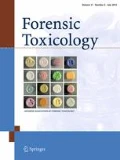Abstract
25I-NBOH is a novel psychoactive substance (NPS) recently reported to have been found on blotter paper samples seized on the streets of Brazil, and used as a replacement for the NBOMes now scheduled in many countries. The presence of this NPS on the street market may go undetected, because the most widely and routinely utilised analytical technique for drug sample analyses is gas chromatography–mass spectrometry (GC–MS), which can misidentify 25I-NBOH (and indeed the other members of the NBOH series), because of its degradation into 2C-I (and corresponding 2C for the other members of the series) within the injector, unless a derivatization procedure is employed, which is often non-standard. While direct detection of 25I-NBOH under routine GC–MS conditions is still achieved, a slight adjustment in the standard GC–MS method, including shortening of the solvent delay window, was found to enable the detection of an additional peak due to 25I-NBOH degradation. Consequently, the presence of this secondary early chromatographic peak allowed for the distinction between 25I-NBOH and 2C-I using routine GC–MS without resorting to derivatization (or other analytical processes), thus preventing misidentification of 25I-NBOH as 2C-I.






References
United Nations Office on Drugs and Crime (UNODC) (2016) World Drug Report 2016. http://www.unodc.org/doc/wdr2016/WORLD_DRUG_REPORT_2016_web.pdf. Accessed Jan 2017
Ninnemann A, Stuart GL (2013) The NBOMe series: a novel, dangerous group of hallucinogenic drugs. J Stud Alcohol Drugs 74:977–978. doi:10.15288/jsad.2013.74.977
Caldicott DGE, Bright SJ, Barratt MJ (2013) NBOMe — a very different kettle of fish. . . Med J Aust 199:322–323. doi:10.5694/mja13.10926
The Vaults of Erowid (2017) 25I-NBOMe (2C-I-NBOMe) Fatalities / Deaths. https://www.erowid.org/chemicals/2ci_nbome/2ci_nbome_death.shtml. Accessed Jan 2017
The Vaults of Erowid (2017) 25C-NBOMe (2C-C-NBOMe) Fatalities / Deaths. https://www.erowid.org/chemicals/2cc_nbome/2cc_nbome_death.shtml. Accessed Jan 2017
The Vaults of Erowid (2017) NBOMe Series – Legal Status. http://www.erowid.org/chemicals/nbome/nbome_law.shtml. Accessed Jan 2017
Braden MR, Parrish JC, Naylor JC, Nichols DE (2006) Molecular interaction of serotonin 5-HT2A receptor residues Phe339(6.51) and Phe340(6.52) with superpotent N-benzyl phenethylamine agonists. Mol Pharmacol 70:1956–1964. doi:10.1124/mol.106.028720
Fantegrossi WE, Gray BW, Bailey JM, Smith DA, Hansen M, Kristensen JL (2015) Hallucinogen-like effects of 2-([2-(4-cyano-2,5-dimethoxyphenyl)ethylamino]methyl)phenol (25CN-NBOH), a novel N-benzylphenethylamine with 100-fold selectivity for 5-HT2A receptors, in mice. Psychopharmacology 232:1039–1047. doi:10.1007/s00213-014-3739-3
Rickli A, Luethi D, Reinisch J, Buchy D, Hoener MC, Liechti ME (2015) Receptor interaction profiles of novel N-2-methoxybenzyl (NBOMe) derivatives of 2,5-dimethoxy-substituted phenethylamines (2C drugs). Neuropharmacology 99:546–553. doi:10.1016/j.neuropharm.2015.08.034
Arantes LC, Ferrari Júnior E, de Souza LF, Cardoso AC, Alcântara TLF, Lião LM, Machado Y, Lordeiro RA, Coelho Neto J, Andrade AFB (2017) 25I-NBOH: a new potent serotonin 5-HT2A receptor agonist identified in blotter paper seizures in Brazil. Forensic Toxicol. doi:10.1007/s11419-017-0357-x
Agência Nacional de Vigilância Sanitária — Ministério da Saúde (2016) Resolução da Diretoria Colegiada-RDC n\(^{\underline{\rm o}}\)117. http://bvsms.saude.gov.br/bvs/saudelegis/anvisa/2016/rdc0117_19_10_2016.pdf. Accessed Jan 2017
European Project Response to Challenges in Forensic Drug Analyses (2016) Analytical report — 25I-NBOH. http://www.policija.si/apps/nfl_response_web/0_Analytical_Reports_final/25I-NBOH-ID-1383-15-report_final.pdf. Accessed Jan 2017
Scientific Working Group for the Analysis of Seized Drugs (2016) SWGDRUG recommendations version 7.1. http://www.swgdrug.org/approved.htm. Accessed Jan 2017
United Nations Office on Drugs and Crime (UNODC) (2016) International Collaborative Exercises (ICE) — sumary report 2016/1. https://www.unodc.org/documents/scientific/International_Collaborative_Exercises_ICE_2016_round_1_summary_report_Seized_Materials.pdf. Accessed Jan 2017
Scientific Working Group for the Analysis of Seized Drugs (2016) SWGDRUG MS library version 3.1. http://www.swgdrug.org/ms.htm. Accessed Jan 2017
Cayman Chemical (2016) Cayman Spectral Library (CSL) v10312016. https://www.caymanchem.com/forensics/csl. Accessed Jan 2017
Acknowledgements
The authors are thankful to Instituto de Criminalística da Polícia Civil de Minas Gerais (IC-PCMG), Polícia Civil do Distrito Federal (PCDF), Fundação de Amparo à Pesquisa do Estado de Minas Gerais (FAPEMIG), Fundação de Apoio à Pesquisa do Distrito Federal (FAPDF) and Fundação de Peritos em Criminalística Ilaraine Acácio Arce (FPCIAA) for providing the samples used in this study and for technical and financial support. José Coelho Neto is supported by Fundo de Incentivo à Pesquisa da Pontifícia Universidade Católica de Minas Gerais (FIP-PUC MINAS).
Author information
Authors and Affiliations
Corresponding author
Ethics declarations
Conflict of interest
The authors declare no conflicts of interest.
Ethical approval
This article does not contain any studies with human participants or animals performed by any of the authors.
Rights and permissions
About this article
Cite this article
Coelho Neto, J., Andrade, A.F.B., Lordeiro, R.A. et al. Preventing misidentification of 25I-NBOH as 2C-I on routine GC–MS analyses. Forensic Toxicol 35, 415–420 (2017). https://doi.org/10.1007/s11419-017-0362-0
Received:
Accepted:
Published:
Issue Date:
DOI: https://doi.org/10.1007/s11419-017-0362-0

